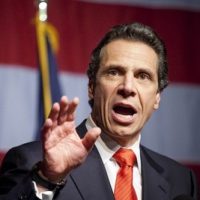Complete Streets legislation, which passed the Assembly earlier this year, has been signed by Governor Cuomo, Chapter 398 of the Laws of 2011.
 Complete Streets will encourage transportation officials to include features that provide convenient access to streets and roads by all users. Such features would include sidewalks, paved shoulders for bicycle use, bicycle lanes, share the road signage, lane striping, crosswalks and pedestrian signals, ramps, bus pullouts and other traffic-calming measures.
Complete Streets will encourage transportation officials to include features that provide convenient access to streets and roads by all users. Such features would include sidewalks, paved shoulders for bicycle use, bicycle lanes, share the road signage, lane striping, crosswalks and pedestrian signals, ramps, bus pullouts and other traffic-calming measures.
Transportation is vital. The Supreme Court has recognized the right to travel as one of the fundamental rights guaranteed by the Fourteenth Amendment to the U.S. Constitution. The Universal Declaration of Human Rights, at Article 13, states, “Everyone has the right to freedom of movement and residence within the borders of each state.” read more
As Governors met last year with the White House to review the proposed $ 50 billion Transportation Bill, one activist, Angela Grover Blackwell was invited. She is the founder and chief executive officer of PolicyLink, “a national research and action institute advancing economic and social equity that chairs the newly formed Equity Caucus, part of Transportation for America, calling on federal policymakers to see equity and social justice as a key part of transportation planning. This is what she had to say:
 “It is interesting that transportation, in recent years, has not been framed as a civil rights issue, because most of the civil rights struggle in this country has centered around transportation, in one way or another, starting with Plessy v. Ferguson [in 1896]. That had to do with access to train cars. Then we have Rosa Parks sitting down on a bus. We had the Freedom Riders trying to do something to show that black people ought to be able to ride a bus across jurisdictions, they ought to be able to ride through the South on a bus without having to go to the back of the bus. The whole urban renewal, which people often call “black removal,” because that’s what happens, in the 60s, was a fight around highways coming in, going right through communities that had been vibrant, often destroying the financial district in an African-American community.” read more…
“It is interesting that transportation, in recent years, has not been framed as a civil rights issue, because most of the civil rights struggle in this country has centered around transportation, in one way or another, starting with Plessy v. Ferguson [in 1896]. That had to do with access to train cars. Then we have Rosa Parks sitting down on a bus. We had the Freedom Riders trying to do something to show that black people ought to be able to ride a bus across jurisdictions, they ought to be able to ride through the South on a bus without having to go to the back of the bus. The whole urban renewal, which people often call “black removal,” because that’s what happens, in the 60s, was a fight around highways coming in, going right through communities that had been vibrant, often destroying the financial district in an African-American community.” read more…
These arguments echo the words of Enrique Penalosa, former Mayor of Bogota. When presenting transportation choices at a meeting in 2007 in New York city , his first words were: “first you have to decide what type of society you want to live in, before you discuss transportation..” . This made clear that the issue is more social engineering than highway engineering. He then proceeded to explain how he chose to use his full transporatation budget for the Millenio, a rapid bus system for the city of Bogota with the goal of bringing public transportation within 500 meters of every resident of the city. Which he did. Inspiring.
Fast forward to Washington where the debate is now being put in this larger context with the Leadership Conference on Civil and Human Rights demanding an end to Car-Centric Transportation Policies: “This is the civil rights dilemma: Our laws purport to level the playing field, but our transportation choices have effectively barred millions of people from accessing it.” “Although our laws promise to open doors to opportunity, As our metropolitan areas have expanded and jobs and services have become more diffuse, equal opportunity depends upon equal access to affordable transportation.”
According to their report, Where We Need to Go: A Civil Rights Roadmap for Transportation Equity racial minorities are four times more likely than whites to lack access to a car and to rely on public transportation for their commute to work. African Americans make up 12 percent of the U.S. population but 20 percent of the pedestrian fatalities. It’s also an economic issue, they say: with job sprawl access to those jobs can be exclusively by private car. Even three out of five jobs “suitable for welfare-to-work participants” are not accessible by public transit, the report says. Transportation is also a housing issue, when people of limited means are priced out of even inexpensive housing because transportation costs are too high outside the city, where transit doesn’t reach. And transportation is a health issue, when people with disabilities who cannot drive skip medical appointments because they have no way to get there. read more

[…] year, Governor Cuomo signed into law The Complete Street Bill. It mostly happened because a mother of a 14 year old girl who was killed by a driver took the […]
[…] year, Governor Cuomo signed into law The Complete Street Bill. It mostly happened because a mother of a 14 year old girl who was killed by a driver took the […]